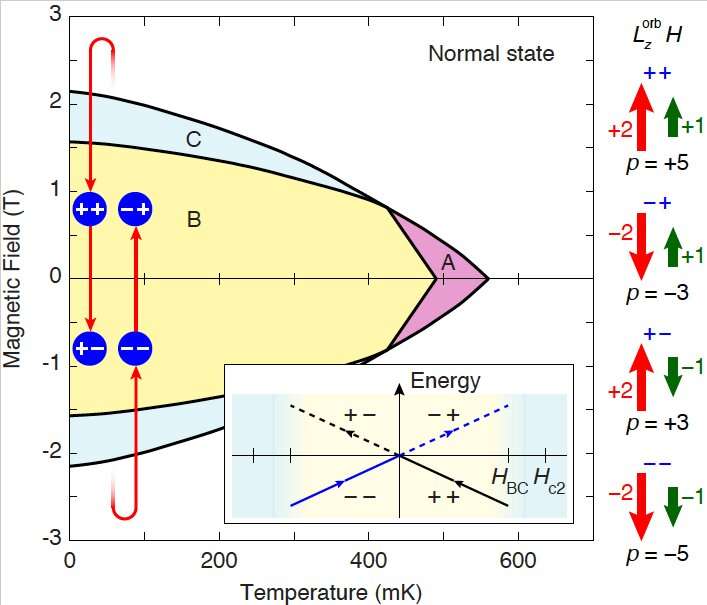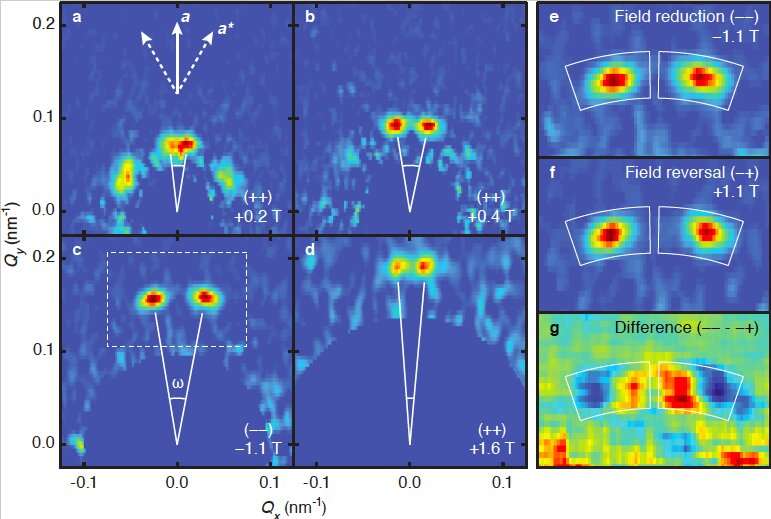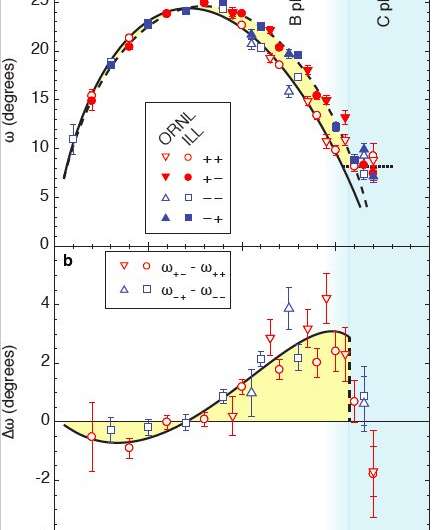March 23, 2020 feature
Evidence for broken time-reversal symmetry in a topological superconductor

Chiral superconductors are unconventional superconducting materials with distinctive topological properties, in which time-reversal symmetry is broken. Two of the first materials to be identified as chiral superconductors are UPt3 and Sr2RuO4. So far, experimental evidence for broken time-reversal symmetry in both these materials was based primarily on surface measurements collected at a magnetic field equal to zero.
Researchers at the University of Notre Dame and Northwestern University, however, recently set out to gather new evidence for the chiral superconductivity of the material UPt3, moving beyond surface measurements at conditions with a zero magnetic field. Their paper, published in Nature Physics, contains the results of truly bulk measurements of UPt3 with an applied magnetic field, which provide direct evidence of broken time-reversal symmetry in the material.
"The measurements we collected are the conclusion of a decade long-term collaboration between William Halperin at Northwestern University and myself, driven by previous (William Gannon) and current (Keenan Avers) graduate students," Morten Eskildsen, one of the researchers who carried out the study, told Nature Physics. "They are especially timely given that recent thermal conductivity and 17O Knight shift measurements call into question the earlier determination of odd parity pairing in Sr2RuO4."
Compared to Sr2RuO4, odd parity f-wave pairing is well established in UPt3. While in UPt3 the B phase is predicted to be a chiral ground state, evidence for BTRS has come, as mentioned above, from surface probe measurements with zero applied magnetic field.

In their experiments, Eskildsen and his colleagues collected bulk measurements of UPt3 using small-angle neutron scattering (SANS), a technique that enables the characterization of material structures at a mesoscopic scale. The specific measurement protocol they used, which entails a comparison between field reduction and field reversal measurements, was devised by James Sauls at Northwestern University, who co-authored the paper.
Vortices introduced in superconducting materials by applying a magnetic field can serve as sensitive probes of the superconducting state in the host material. In their study, Eskildsen and his colleagues used vortices to probe the superconducting state in ultraclean UPt3 crystals, specifically by applying SANS studies of the material's vortex lattice.
"Vortices allow measurements as a function of magnetic field strength and probe bulk superconducting properties, as opposed to surface properties," Eskildsen said. "Our measurements were collected at two of the leading neutron scattering facilities: Oak Ridge National Laboratory in Tennessee (US) and Institut Laue Langevin in Grenoble (France). "The measurements were made possible by a long-term effort at Northwestern University to produce single crystals of UPt3 with an unprecedented high quality."

The recent study by Eskildsen and his colleagues offers the first direct evidence of BTRS in the material UPt3 based on bulk measurements, ultimately demonstrating an internal degree of freedom in its superconductivity (i.e. the ability to obtain different vortex lattice splitting depending on the field history). In addition to confirming the BTRS of UPt3, these findings could encourage other research teams to use similar measurement techniques to study other unconventional superconductors.
"We do not currently have further plans for this material, but the kind of measurement protocols could be used in small-angle neutron scattering studies of other superconductors that might break time reversal symmetry," Eskildsen said.
More information: K. E. Avers et al. Broken time-reversal symmetry in the topological superconductor UPt3, Nature Physics (2020). DOI: 10.1038/s41567-020-0822-z
E. Hassinger et al. Vertical Line Nodes in the Superconducting Gap Structure of Sr2RuO4, Physical Review X (2017). DOI: 10.1103/PhysRevX.7.011032
A. Pustogow et al. Constraints on the superconducting order parameter in Sr2RuO4 from oxygen-17 nuclear magnetic resonance, Nature (2019). DOI: 10.1038/s41586-019-1596-2
Journal information: Nature Physics , Physical Review X , Nature
© 2020 Science X Network





















